Anniversary of the Second Exhumation of the Relics of St. Therese of Lisieux (August 9-10, 1917)
The Second Exhumation of the Relics
of St. Therese of Lisieux
August 9 and10th, 1917
from the Archives of the Carmel of Lisieux
An eyewitness account of the second exhumation and the recognition of the remains of the Servant of God, Thérèse of the Child Jesus, published by the Diocese of Bayeux on August 15, 1917, five days after the exhumation.
Translated from Remembrance of the second exhumations and closure of the Apostolic Process of Sister Thérèse of the Child Jesus, in the Diocese of Bayeux, not paginated.
The first exhumation on September 6, 1910, was done under the sole inspiration of His Grace, Bishop Lemonnier, Bishop of Bayeux and Lisieux. It consisted solely of putting the unchanged remains back into a new coffin for better preservation. But before the closing of the Apostolic Process of the Cause of Sister Thérèse of the Child Jesus, in order to respond to the rules of the Church, we had to proceed to an anatomical recognition of the bones by doctors under oath.
For this purpose, Monseigneur the Bishop of Bayeux, accompanied by Monsignor de Teil, Vice-postulator, and members of the Ecclesiastical Court, dressed in choir habit, went to the cemetery in town in the afternoon of August 9, 1917.
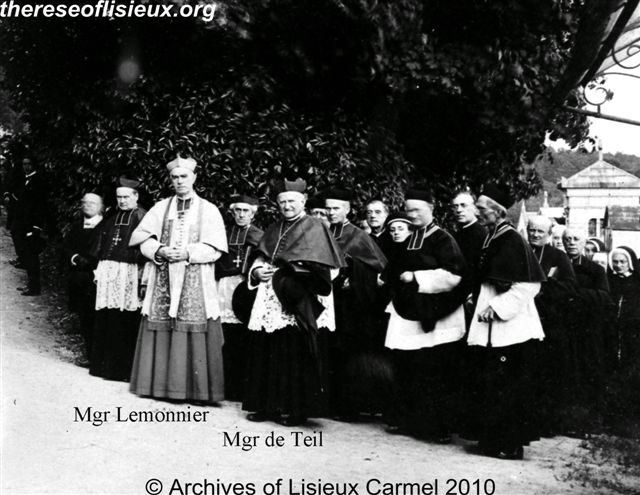
Monseigneur Lemonnier, Bishop of Bayeux and Lisieux,
with Mgr. de Teil, Vice-Postulator of the Cause of Sister Therese of the Child Jesus
We first removed from the small tomb built in 1910 the oak lead coffin which had been deposited at that time and transported it to the cemetery chapel, which the municipality had kindly placed at the service of the priests and the doctors.
This translation was not done in the Carmelite Monastery in order to avoid excessive traffic en route, crowds that would have seemed a premature glorification of the Servant of God. For the same purpose, we tried as much as possible to keep the ceremony a secret. Otherwise, if we had let the news be known, the whole city would have been standing there the next day. Nevertheless, the news emerged: witness this word by a wounded man in an ambulance drawn by some religious. “How is it, my sister, that you do not tell us what will happen up there? Ah! do you not speak of what will happen up there? Ah well! Know that all the crutches will be there!”
Thus, about 3,000 people were standing for nearly two whole days at the cemetery, where the small Carmelite enclosure modestly sprawls on the hill.
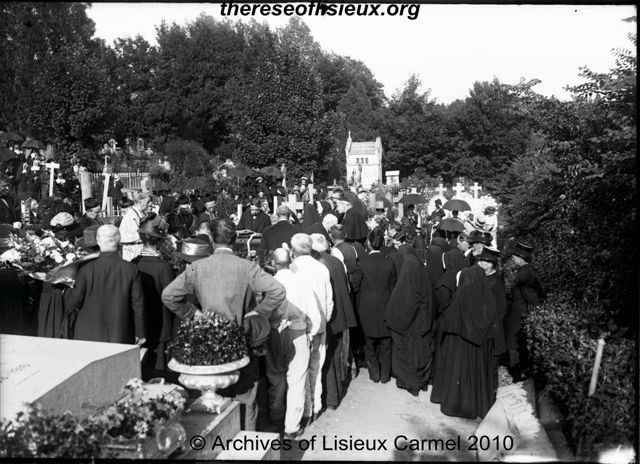
“It’s incredible!” naively exclaimed one worker from Lisieux, “Will Liisieux become the capital of the world?” Meanwhile, a dam was erected to maintain the crowd at a respectful distance. The Director of the Henry Borniol House, whose clever initative had assured the happy success of the 1910 exhumation, again directed the delicate operation of its best workers.
As soon as the large oak coffin, blackened and damaged, appeared on the floor level, Monseigneur the Bishop, yielding to the same inspiration as seven years before, began the psalm "Laudate pueri Dominum," which was continued by the assistants.
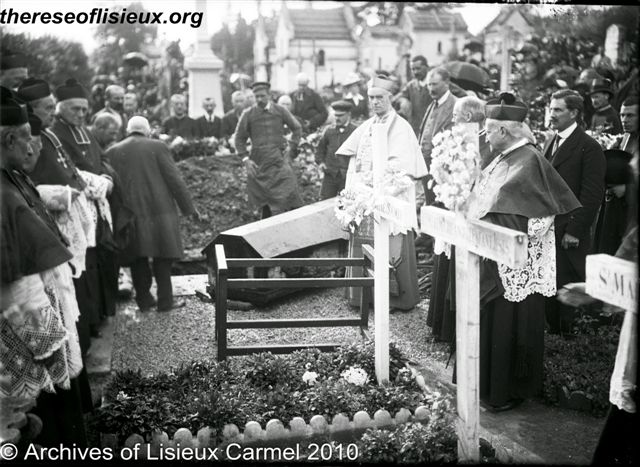
Then, amidst an impressive silence, the Bishop, on behalf of the Holy Church, pronounced excommunication against anyone who would dare steal the smallest fragment body, clothing, or coffin of the Servant of God, Thérèse of the Child Jesus.
Then a procession formed in the most perfect order to accompany the first-class hearse to the mortuary of the cemetery. It was at this precise moment, from the testimony of a privileged few, that there, at the Monastery of Carmel, mysterious scents suddenly spread. On the white sheet that covered the coffin, the Carmelites had to extend the great homespun scapular, recalling the expensive and austere livery of the humble virgin Thérèse.
The surveillance service was established to stop the enthusiastic acts that could have burst out, until a brave soldier, rushing towards a car, touched his helmet to the casket and piously kissed it. It was nearly six o’clock when the cemetery chapel, containing the revered remains was sealed closed by Monseigneur the Bishop and the Police Commissioner, to rigorously defend access to it. Soon a watch of four men of goodwill, in addition to the civil guard, was organized in the tent as an extension of the chapel; amongst them, two licensees on leave, arriving from the front, held it an honor to volunteer themselves on this special evening.
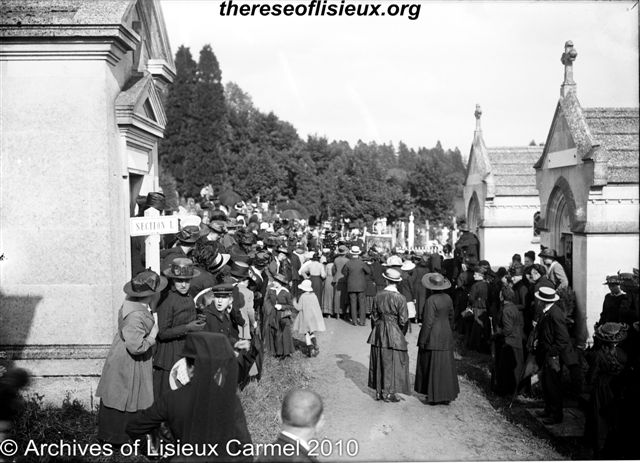
The following day, August 10, at 3:45 a.m., His Grace Monseigneur Lemonnier, Monseigneur de Teil, the other ecclesiastical officers, and the doctors arrived at the cemetery. A fifth car followed them, carrying two Carmelite nuns who had been authorized by the bishop to leave their enclosure so that they might themselves dispose of the precious bones, once recognized. The youngest sister of the Servant of God had the opportunity to give Thérèse the last testimony of her tenderness, which had become a veneration.
Once the lead coffin was opened, we could affirm that the clothing placed seven years ago on the mortal remains of Sister Thérèse, had no more consistency than the former clothing. It had fallen to lint. What seemed most remarkable was the perfect conservation of a wide white silk ribbon, still bearing the shiny gold inscription; “I want to spend my heaven doing good on earth. After my death, I will let fall a shower of roses.” This banner adorned with a bouquet of flowers had been laid on the tomb of Sister Thérèse of the Child Jesus at the end of August 1910, and the Carmelites had used it to tie up some roses gathered from their garden and placed it in the casket on September 6. Is this not a reason tosee this as a survival of the spirit of Sister Thérèse? Her virginal remains were not, in the designs of divine wisdom, to be exempted from corruption, but this double prophecy, which summarizes her heavenly vocation, was kept intact as a token of hope for those who implore her aid.
It was moving to see the two prelates and the other priests of the Commission, the highest-ranking diocesan clergy, bent over the poor coffin and taking the smallest parcels of dry bones with a jealous care to present them to the doctors After having recovered almost all of them, the fraternal hands worked with such religious enthusiasm! to rid them of their earthly part, as one does for a diamond of value, and successively wrapped in cloths of fine linen, tied with silk ribbons. They were deposited in a carved oak box lined with white satin.
Before affixing the seals of the Bishop of Bayeux and of the Municipality, the Bishop wanted to show the assistants the cover of this pretty casket, where one could see, in the center of the cross entwined with a crown of raised thorns, the effigy of the Holy Face, and the various implements of the Passion, as well as the crest of Mount Carmel. The NCO licensee, who had spent the night near the chapel, took the cover and visibly moved, made it circulate in the pressing ranks of the spectators. Many tears flowed when kissing the image of the Savior, and also the homespun scapular. The sacristan of Carmel alone estimated at more than 12,000 the number of objects that the crowd of the faithful begged him to touch, for them, to the bones of the angelic Servant of God.
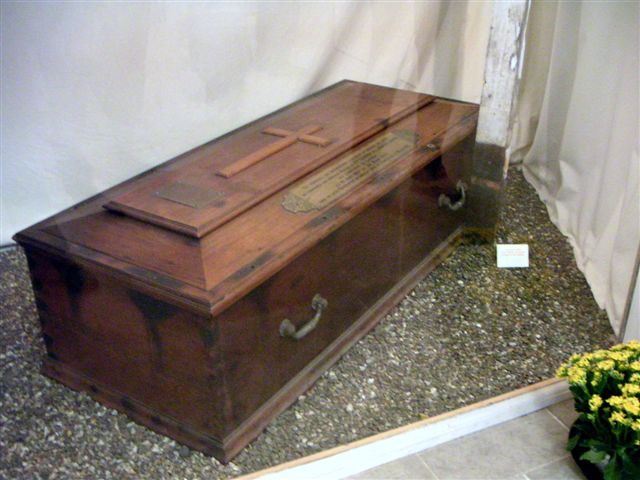 The rosewood coffin which contained the body of Sister Therese from August 10, 1917 until her body was returned to Carmel on March 26, 1923. Photo credit: Susan Ehlert
The rosewood coffin which contained the body of Sister Therese from August 10, 1917 until her body was returned to Carmel on March 26, 1923. Photo credit: Susan Ehlert
The box, 1m 20 in width, 40 cm in height, and 30, was placed in a lead coffin draped with white cloth, which was itself enclosed in a rosewood coffin decorated with four finely chilsed silver handles and fourteen screw bolts, themselves made of metal. This very valuable work was offered to the Carmel and to Sister Thérèse by the House of Henri de Borniol. On the top section, sealed with the episcopal coat of arms, one could read the artistically engraved inscription:
HIC
OSSA ANCILLAE DEI
THERESIAE A PUERO JESU
DEPOSITA SUNT
DIE DECIMA AUGUSTI
MCMXVII
HERE
THE BONES OF THE SERVANT OF GOD
THÉRÈSE OF THE CHILD JESUS
WERE DEPOSITED
AUGUST 10
1917
[In 2008, we reintroduced in this empty box conserved in our archives the lead tube—open--which contained a certificate attesting to the bones of Thérèse, signed by all the participants of the exhumation, including Sister Genevieve and Sister Madeleine of Jesus.]
Even though the hearse had been kept there, the employees, in the livery of the ceremony, reclaimed the honor of carrying the casket, on their shoulders, back to the burial site. Wreaths of flowers appeared on all sides in the wake of the procession, which advanced majestically under the setting sun of this beautiful day.
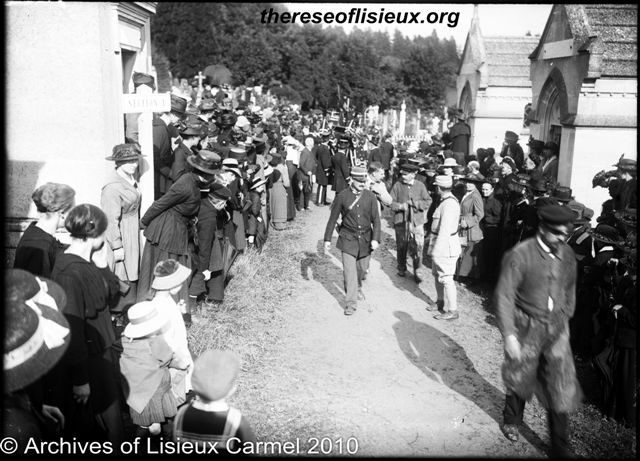
The same order and sympathetic piety recorded the day before kept the event of a private nature and full of a recollected calm. Not to take away this aspect, otherwise required by the rules of the Church, Monsignor Lemonnier refrained from translating aloud his feelings, which were those of all, and the porters desposited their precious burdens in silence, in the brick vault in the shadow of the white cross covered with inscriptions of requests.
These blessed remains now await the decision of the Holy Church, and from here on, do they not continue to work their good deeds in mystery? The Gospel of August 10, gently reminded us of this consoling word of Jesus : "If a grain of wheat falls to the earth and dies, it bears much fruit."
Some incidents, gleaned here and there during these days, helped to make them still more moving, such as the fact of the perfumes already reported, which a military chaplain, among others, perceived on a Friday, around the mortuary. Citing now the word gathered from the mouths of many, and summing up a general feeling: “Without a doubt, these long hours of waiting in front of a closed chapel are painful, but what does it matter, if we add through this fatigue to the glory of our little saint!” And yet this cry escaped a poor mother when a gravedigger wanted to prevent her from reaching a board separated from the coffin: “It is clear that you, you do not have a son at the front!”.
Why not also mention the exclamation of an employee of the train station of Lisieux when he saw the rosewood trunk; “Nothing will ever be too beautiful for Sister Thérèse!”
When everything seemed finished at the cemetery, Bishop Lemonnier, accompanied by the Ecclesiastical Court, went to the Carmelite Monastery, where before the assembled community, he gave a lecture to recount the events of August 9 and 10. Then they affixed the seals on the remains of the hair and other fragments of the body of the Servant of God, and even the old coffins confided to the discreet custody of the religious. Henceforth, it will no longer be permitted to distribute these intimate souvenirs until a decision of the Holy See assigns them the character of relics, entitling them to the veneration of the faithful. Anxious, indeed, to ensure the conservation, as complete as possible, of all that remains of the bodies of her saints, the Church, like a Mother full of caution, recognizes, by this means, that she is the only owner and prohibits premature distribution.
This prohibition may be a matter of real sacrifice for many devotees of Sister Thérèse of the Child Jesus, but may they remember that a simple movement of faith attracts her protection, and let them hope much that her compassionate goodness is always the best way to take her by the heart.
LICENCE TO PRINT: BAYEUX, AUGUST 15, 1917
THOMAS, Bishop of Bayeux and Lisieux
[Note: By the gracious permission of the Archives of the Carmel of Lisieux, this manuscript was translated into English for "Saint Therese of Lisieux: A Gateway" by Monique Pilon-Fraschetti in 2010 and edited by Maureen O'Riordan. We are most grateful to the Archives for their kind permission to make and publish the translation and for the photographs. Since the original publication of this English translation in 2010, more and bigger photographs of the second exhumation have been published at the Web site of the Archives of the Carmel of Lisieux. View these photos of the 1917 exhumation].
Reader Comments